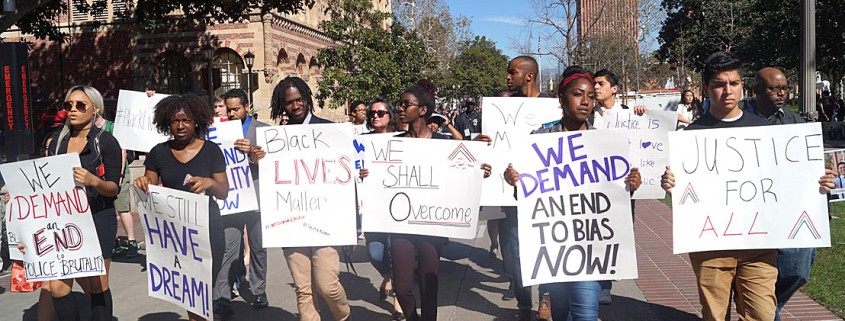BSA holds commemorative march on campus
“Just as Dr. King asked all those thousands, I encourage you to uplift his legacy by continuing to dream,” Omete Anassi said to a crowd of onlookers in front of Tommy Trojan Wednesday afternoon. “Continue to dream that Martin Luther King Jr.’s ‘I Have a Dream’ speech will no longer be applicable to our nation because it will be fully realized.”
Anassi, a junior majoring in neuroscience, was joined by approximately 50 students and community members who gathered for the Black Student Assembly’s March on Trousdale event in commemoration of Black History Month and Martin Luther King Jr.’s March on Washington.
The march began at the Finger Fountain at approximately 11:20 a.m. In commemoration of the original 1963 march, students donned business attire and marched with signs reading, “We demand an end to police brutality,” “Black Lives Matter” and “Get in #Formation.”
BSA’s Next Generation Co-Chair Amaka Agodi said she and her fellow organizers were intentional about having a silent protest.
“We decided on a silent march because we thought it would be more impactful and convey a message of us trying to commemorate Martin Luther King Jr.’s March on Washington,” Agodi said. “We wanted to have it during Black History Month because it’s important to keep ourselves grounded and remember why we’re doing this and how far we’ve come.”
The march went through the Ronald Tutor Campus Center, where participants assembled themselves along the Steps of Troy and paused for a moment of silence. The moment of silence, which was symbolically held for four minutes in honor of the four hours teenager Michael Brown was left on the street after being shot by police in Ferguson, Missouri in August 2014, was also held in honor of Black Lives Matter activist MarShawn McCarrel, who committed suicide Monday.
Moira Turner, a junior majoring in anthropology and Undergraduate Student Government’s director of Diversity Affairs, highlighted the importance of the march going through main University centers.
“TCC is one of the golden hallmarks of USC,” Turner said. “So the fact that we could occupy that space and insert ourselves there to say that Black Lives Matter and that black students’ lives matter and that our mental health matters was very important.”
Though the event was organized by the BSA, the event drew out a diverse crowd of students. USG presidential candidate Edwin Saucedo, who is Latino, stressed the importance of solidarity among students.
“A big reason I came out was to stand in solidarity and support our groups on campus,” Saucedo said. “I think that it’s important to show a presence of the different issues we are experiencing across the nation and have people engaging in those conversations on campus.”
The march concluded in front of Tommy Trojan, where Center for Black Culture and Student Affairs Director Corliss P. Bennett-McBride led participants in singing the black national anthem, “Lift Every Voice and Sing.” This was followed by a spoken word rendition of King’s iconic “I Have a Dream” speech performed by Anassi, which he entitled, “Is the black American free?”
Though most of the participants were students, a number of members from the local community also took part in the event. Representatives from the Professional Community Intervention Training Institute, a local organization that trains and professionally certifies gang and crisis interventionists, encouraged students to create multi-disciplinary collaborations and partnerships.
“We were there for the originally ’63 march, for the March on Washington,” a PCITI representative said to the students. “Youth have led the movement and I say that to say that you guys are the leadership of what this country is going to look like in the next five, 10, 15 years. We are elders in the process … Use us to assist you in designing the direction you want to take — but you have to design the process.”
Some students expressed their frustration with the lack of administrative response to the event. Turner said that though both University President C. L. Max Nikias and Provost Michael Quick walked by the march, they did not respond to requests to address it.
“[The administration’s] complete and total silence is disheartening coming from a black student perspective on campus,” Turner said.
To BSA Executive Director Mykaila Williams, one of the primary goals of the march was to provide necessary spaces for students on campus.
“I’m hoping that what resonates with students is that they do have these opportunities on campus,” Williams said. “So they can say, ‘Even though I didn’t go to it, they do have marches on campus’. They do these kinds of things that give students the space to operate in the way that they want.”

